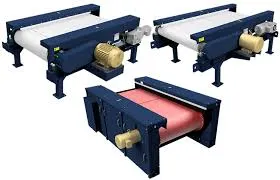

Nov . 16, 2024 18:55 Back to list
Eddy Current Recycling Revolutionizing Waste Management
In an age where sustainability and resource conservation have become paramount, innovative technologies are pivotal in shaping the future of waste management. One such groundbreaking method is the eddy current recycling technique, a process that efficiently separates and recycles non-ferrous metals from mixed waste streams. This technology not only enhances the efficiency of recycling operations but also contributes significantly to environmental sustainability.
Understanding Eddy Currents
To grasp the principle of eddy current recycling, it's essential to first understand what eddy currents are. Eddy currents are loops of electrical current that are induced within conductors when they are exposed to a changing magnetic field. This phenomenon arises from Faraday's law of electromagnetic induction and is utilized in various applications, from induction heating to non-destructive testing. In the context of recycling, eddy currents are harnessed to separate metallic materials effectively.
The Process of Eddy Current Recycling
The eddy current recycling process typically involves several key steps. Initially, mixed materials, including plastics, metals, and other waste, are fed into a recycling plant. The first stage usually involves shredding these materials into smaller fragments. Once the waste is prepared, it is subjected to a magnetic field created by an eddy current separator.
As the shredded material passes through the magnetic field, non-ferrous metals such as aluminum and copper are influenced by the eddy currents generated within them. These eddy currents produce a magnetic field that repels the metals, forcing them to be ejected from the main waste stream into a separate collection area. This method is particularly advantageous because it operates with a high degree of accuracy, minimizing contamination and maximizing the recovery rate of valuable materials.
Advantages of Eddy Current Recycling

Eddy current recycling offers a plethora of benefits, making it an increasingly popular choice among recycling facilities worldwide. One of the primary advantages is its efficiency. The technology can process large volumes of waste quickly, significantly reducing the time and labor involved in manual sorting.
Moreover, eddy current systems can achieve high recovery rates for non-ferrous metals, often reaching over 90%. This high efficiency not only helps in conserving valuable resources but also reduces the environmental impact associated with mining and processing new raw materials. As a result, companies can lower their carbon footprint and contribute to a circular economy where materials are continuously reused rather than discarded.
Another noteworthy benefit is the reduction in contamination rates. Traditional recycling methods often struggle with separating metals from non-metal materials, leading to mixed streams that are harder to process. Eddy current systems excel in this regard, offering a cleaner output stream that can be easily processed further or sold directly to manufacturers.
Environmental and Economic Impact
The environmental implications of adopting eddy current recycling techniques are significant. By enhancing the recovery of metals, these systems help reduce the need for mining, conserving energy and minimizing habitat destruction. The recycling of metals like aluminum saves up to 95% of the energy required to produce new aluminum from ore. This energy efficiency translates to fewer greenhouse gas emissions, which is critical in the fight against climate change.
Economically, eddy current recycling is a smart investment. Businesses that implement this technology can benefit from cost savings associated with reduced landfill usage and the increased value from recovered materials. Furthermore, the recycling industry plays a vital role in job creation, with modern facilities employing skilled workers to operate and maintain advanced machinery.
Conclusion
As we strive to create a more sustainable future, the adoption of advanced recycling technologies such as eddy current recycling will be crucial. This innovative method not only streamlines the recycling process, making it more efficient and effective, but also supports environmental conservation and economic growth. By harnessing the power of eddy currents, the recycling industry is paving the way for a greener planet and a more resource-efficient economy. In an era marked by environmental challenges, embracing such technologies is not just wise—it is essential.
Latest news
Troubleshooting Common Eddy Separator Problems
NewsJul.04,2025
The Role of Metal Recycling Plants in Circular Economy
NewsJul.04,2025
The Impact of Recycling Line Pickers on Waste Management Costs
NewsJul.04,2025
Safety Features Every Metal Shredder Should Have
NewsJul.04,2025
How Industrial Shredders Improve Waste Management Systems
NewsJul.04,2025
How Cable Granulators Contribute to Sustainable Recycling
NewsJul.04,2025